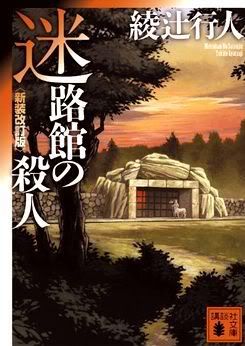 Prominent mystery writer Miyagaki Youtarou invites his 4 disciples, a literary critic, an editor and his wife and mystery maniac Shimada Kiyoshi to his underground labyrinth mansion. However he is found dead when they arrive and a tape tells his disciples of his wish to improve their skills under the condition of being locked into this closed circle situation and write themselves into their works using his mansion as location. Their works are to be evaluated by the critic and the editor and the winner is going to inherit Miyagaki's entire fortune. The authors begin to write their individual stories and it does not take long until murders happen according to those scripts.
Prominent mystery writer Miyagaki Youtarou invites his 4 disciples, a literary critic, an editor and his wife and mystery maniac Shimada Kiyoshi to his underground labyrinth mansion. However he is found dead when they arrive and a tape tells his disciples of his wish to improve their skills under the condition of being locked into this closed circle situation and write themselves into their works using his mansion as location. Their works are to be evaluated by the critic and the editor and the winner is going to inherit Miyagaki's entire fortune. The authors begin to write their individual stories and it does not take long until murders happen according to those scripts.Awesome meta-mystery. In fact this was the work which inspired all the later authors when trying themselves at writing similar books. This third novel in Ayatsuji's series combines aspects of both preceding works, wrapped up in a meta-frame. So you not only have the murders depicted in Shishiya's novel to think about, you also have to guess why he wrote this novel in the first place and you always have to consider while reading the book that you are dealing with a literary re-enactment of the incident. Which makes this a very lush reading experience.
The speedy deductions and (possible) solutions remind of Ayatsuji's debut work, while the overall atmosphere and the usage of a huge attraction-like mansion are similar to suishakan no satsujin. The similarity to an attraction becomes even more apparent in this work, which came almost close to hindering the development of a tense uncanny atmosphere, but Ayatsuji gladly managed to get his act together soon enough.
While the deductions and solutions are not as fair and logical as in his second work, the clues are certainly planted in a more clear and careful way. I realized some aspects shortly before Shimada was going to unveil them anyway, while some other clues and possibilities simply did not come into my mind. Or I discarded them earlier because I did not expect Ayatsuji to be so daring, which in fact is just naive as a reader. Especially in Ayatsuji's case who invented narration- and meta-tricks as they are today.
There really is a lot going on over the course of the novel, you almost feel like sitting in a roller coaster sometimes. Some stuff is solved pretty early, while other questions are finally answered at the very end. You have to be even more careful as in his second work, but if you are pretty much everything is possible to guess. In theory. Even the secret doors that can be found in each of Nakamura Seiji's constructions can be located by careful observation. Well, at least the important one...
I like this third novel in the yakata-series at least as much as the second one. For me they both had their positive aspects. In suishakan I liked the atmosphere and the plot construction of past and present while here I like the sheer mass of murders, clues, tricks and gadgets thrown at you, so I don't have a personal preference, but I would have to say that meirokan is more unique in the context of detective fiction in general while suishakan was the classic one in an absolutely positive sense.
No comments:
Post a Comment